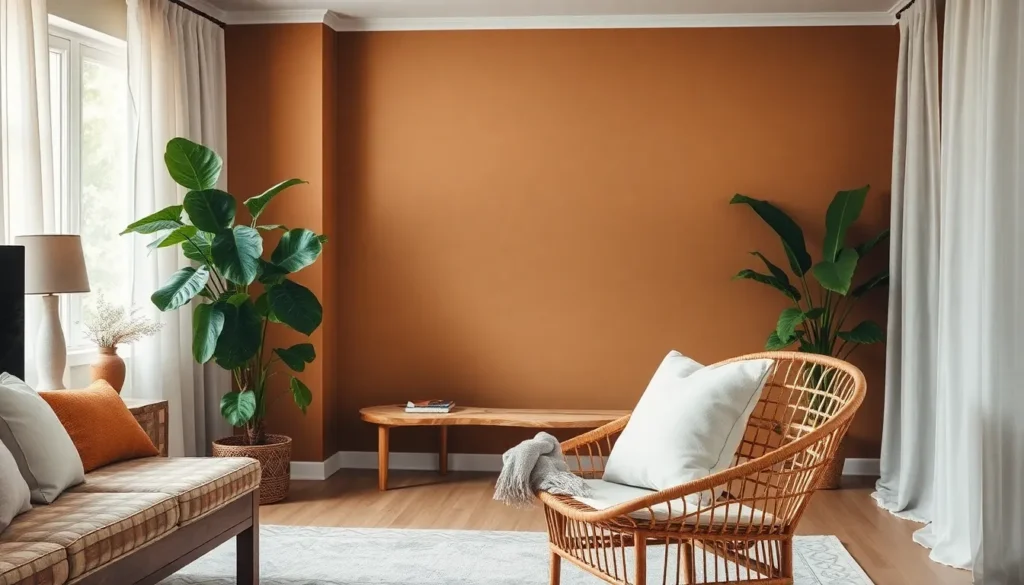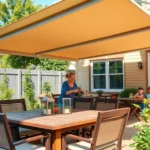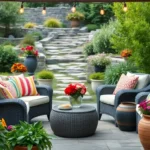We’re living in an era where environmental consciousness meets stunning interior design and the living room has become the perfect canvas for showcasing our commitment to sustainable style. Green living room ideas aren’t just about choosing eco-friendly materials anymore – they’re about creating spaces that breathe life into our homes while reducing our carbon footprint.
The beauty of sustainable design lies in its versatility. We can transform any living space into an eco-conscious haven without sacrificing comfort or aesthetic appeal. From repurposed vintage furniture to energy-efficient lighting answers green design choices often prove more cost-effective and durable than traditional alternatives.
Whether you’re planning a complete room makeover or looking for simple swaps that make a meaningful impact we’ve gathered innovative approaches that’ll help you create a living room that’s both environmentally responsible and absolutely gorgeous. These practical answers prove that going green doesn’t mean compromising on style.
Embrace Natural Plant Life for Air Purification and Ambiance
Bringing living greenery into our sustainable living rooms creates an immediate connection with nature while actively improving indoor air quality. Strategic plant placement transforms sterile spaces into vibrant ecosystems that benefit both our health and design aesthetics.
Large Floor Plants as Statement Pieces
Fiddle leaf figs serve as dramatic focal points while filtering formaldehyde and benzene from indoor air. These sculptural beauties reach heights of 6-10 feet indoors and create instant visual impact in corners or beside furniture groupings.
Monstera deliciosas offer striking split leaf patterns that add tropical flair to modern green living rooms. Their broad foliage captures dust particles and releases oxygen efficiently, making them both decorative and functional air purifiers.
Snake plants thrive in low light conditions and continue producing oxygen throughout the night. We recommend placing these vertical accent plants near seating areas where their air cleaning benefits directly impact our daily comfort.
Rubber trees provide glossy, substantial foliage that complements contemporary furniture while removing airborne toxins. Their sturdy trunks and dense canopies make excellent natural room dividers in open concept living spaces.
Hanging Gardens and Wall-Mounted Planters
Macrame plant hangers create vertical interest without consuming valuable floor space in compact living rooms. Suspended pothos and spider plants cascade gracefully while filtering common household pollutants like xylene and toluene.
Living wall systems transform blank walls into breathing art installations that dramatically improve air quality. These modular planters accommodate multiple plant varieties including ferns, philodendrons, and flowering species that add color and texture.
Ceiling mounted planters draw the eye upward and make rooms feel more spacious while housing trailing plants. Boston ferns and English ivy excel in these elevated positions, creating natural curtains that soften harsh architectural lines.
Wall pocket gardens use vertical surfaces efficiently for herb cultivation and small decorative plants. These space saving answers work particularly well in apartments where floor space is limited but wall area is abundant.
Low-Maintenance Succulents and Air Plants
Aloe vera plants require minimal watering while providing natural first aid remedies and air purification benefits. These practical beauties thrive on windowsills and side tables, adding sculptural interest without demanding daily attention.
Jade plants symbolize prosperity and good fortune while tolerating neglect better than most houseplants. Their thick, glossy leaves store water efficiently, making them perfect for busy homeowners seeking green living room answers.
Air plants need no soil and absorb moisture directly from the atmosphere, making them incredibly versatile for creative displays. Tillandsias can be mounted on driftwood, displayed in glass terrariums, or suspended in geometric holders throughout the room.
Echeveria rosettes form perfect geometric patterns that complement modern design aesthetics while requiring water only every 2-3 weeks. These drought tolerant specimens add soft colors and interesting textures to coffee tables and shelving arrangements.
Choose Sustainable Furniture Made from Eco-Friendly Materials
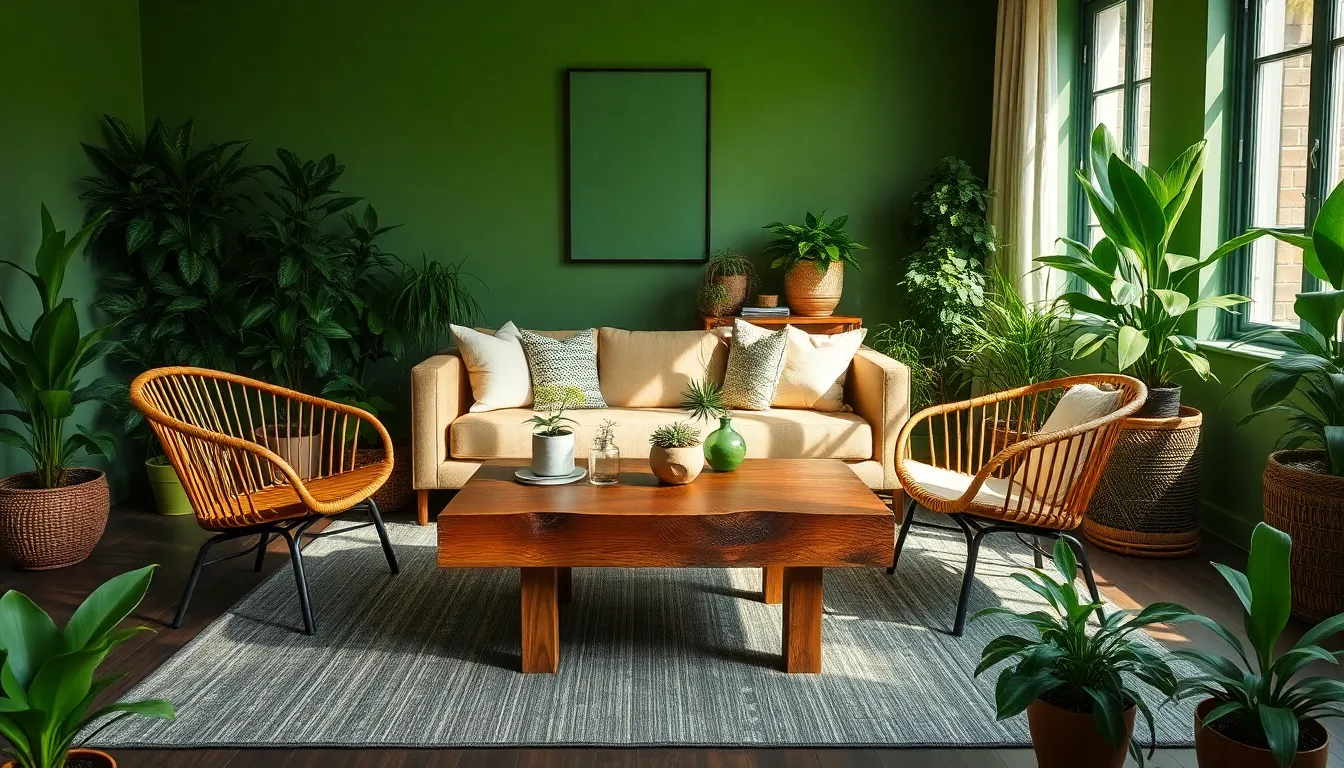
Building on our foundation of sustainable design principles, we can transform our living spaces with furniture choices that reflect our environmental values. Selecting pieces crafted from eco-friendly materials creates the perfect bridge between style and sustainability.
Reclaimed Wood Coffee Tables and Shelving
Reclaimed wood furniture pieces serve as conversation starters while reducing our environmental footprint. Sources for this unique material include old buildings and managed urban trees, diverting potential waste from landfills and giving new life to forgotten resources. Coffee tables made from reclaimed wood showcase distinctive grain patterns and weathered textures that mass-produced furniture simply can’t replicate.
Shelving units constructed from salvaged materials offer both functionality and character to our green living rooms. Each piece tells its own story through nail holes, paint remnants, and natural imperfections that add visual interest. Companies increasingly partner with local artisans to create custom pieces using resources within a limited radius, minimizing transportation emissions while supporting local economies.
Storage answers using reclaimed wood help us organize our spaces sustainably. Floating shelves, bookcases, and media consoles made from these materials complement various design styles from rustic to modern industrial.
Bamboo and Rattan Seating Options
Bamboo seating transforms our living areas with its renewable properties and natural aesthetic appeal. This fast-growing plant reaches maturity in just three to five years, making it one of the most sustainable furniture materials available. Dining chairs, accent chairs, and even sofas crafted from bamboo offer durability that rivals traditional hardwoods while maintaining a lighter environmental impact.
Rattan furniture brings tropical warmth to our eco-conscious spaces through its flexible weaving capabilities. Armchairs, love seats, and ottoman sets made from this climbing palm provide comfortable seating options that age beautifully over time. Both bamboo and rattan materials are lightweight yet sturdy, making furniture rearrangement effortless when we want to refresh our room layouts.
Decorative elements like plant stands, side tables, and room dividers showcase these renewable materials’ versatility. Natural finishes on bamboo and rattan pieces complement our indoor plants while maintaining the cohesive green aesthetic we’re cultivating.
Vintage and Secondhand Furniture Finds
Vintage furniture shopping extends the lifespan of existing pieces while reducing demand for new resource extraction. Thrift stores, estate sales, and online marketplaces offer unique finds that add personality to our sustainable living rooms. Mid-century modern pieces, antique wooden chests, and retro upholstered chairs bring history and character that new furniture often lacks.
Secondhand purchases typically cost significantly less than buying new, allowing us to invest in quality pieces that might otherwise exceed our budgets. Refinishing vintage wood furniture with low-VOC stains and paints lets us customize colors while maintaining eco-friendly practices. Reupholstering vintage seating with sustainable fabrics creates personalized pieces that reflect our individual style preferences.
Estate sale discoveries often include solid wood construction that surpasses modern furniture quality. Dining tables, dressers repurposed as media consoles, and vintage lighting fixtures become focal points that spark conversations about sustainable living choices.
Incorporate Energy-Efficient Lighting Solutions
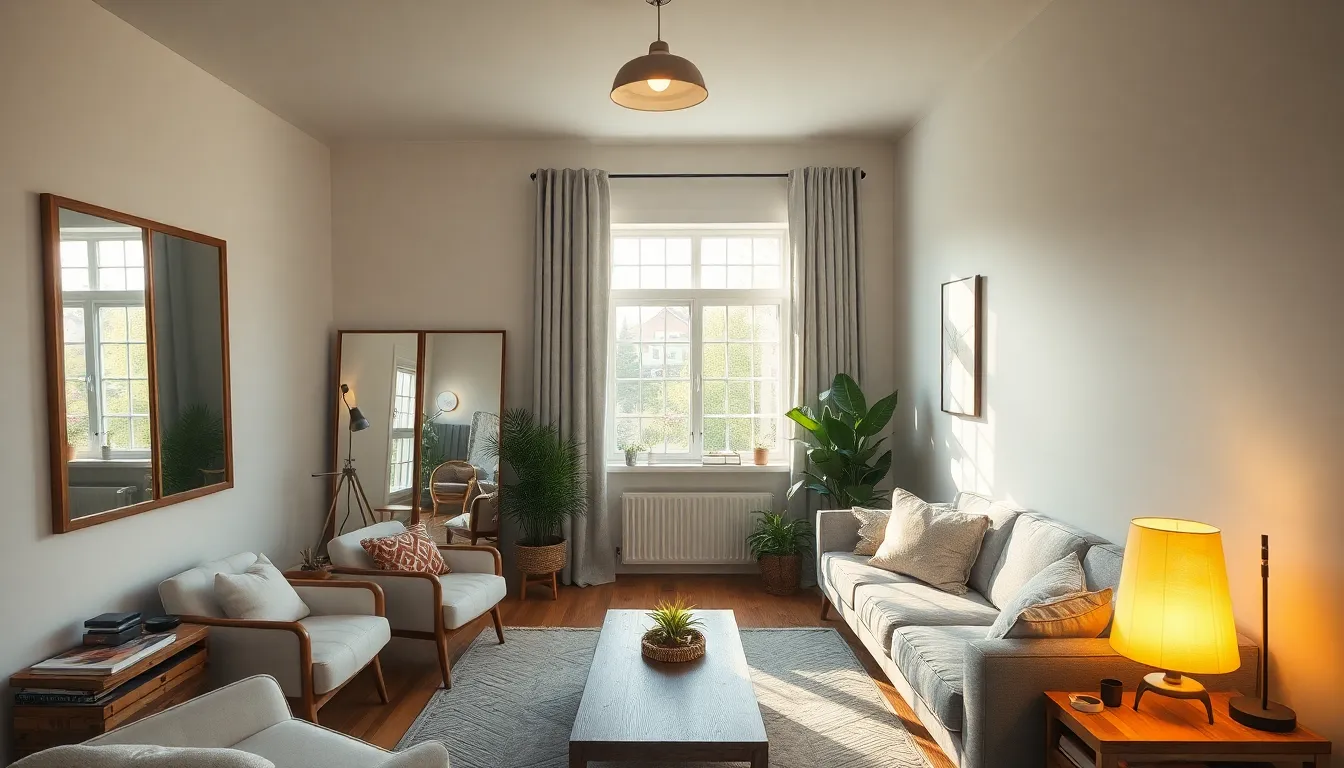
Lighting transforms our green living spaces while dramatically reducing energy consumption and environmental impact. We’ll explore three powerful strategies that combine sustainability with style.
LED Bulbs and Smart Lighting Systems
LED bulbs consume at least 75% less energy than traditional incandescent bulbs while lasting up to 25 times longer. We significantly reduce both energy costs and waste by making this simple switch in our living rooms.
Smart lighting systems take efficiency even further by automating brightness levels based on room occupancy and natural light availability. These systems allow us to schedule lighting patterns, control fixtures remotely, and optimize energy use throughout the day. Modern smart bulbs can dim automatically during peak sunlight hours and brighten as evening approaches.
Installation proves straightforward since most smart bulbs fit standard fixtures and connect directly to our smartphones or home automation systems. We can create custom lighting zones for reading areas, entertainment spaces, and ambient lighting without rewiring existing fixtures.
Natural Light Maximization with Mirrors
Natural light reduces our dependency on artificial lighting while creating brighter, more inviting living spaces. We maximize daylight by using sheer curtains that filter light without blocking it completely.
Strategic mirror placement amplifies existing sunlight throughout our rooms. Positioning mirrors opposite windows reflects and doubles natural light, illuminating darker corners and reducing the need for daytime artificial lighting. Large floor mirrors work particularly well for this purpose in smaller living rooms.
Multiple smaller mirrors create light bouncing effects that distribute sunshine more evenly across our spaces. We can arrange decorative mirror clusters on walls adjacent to windows to capture and redirect morning or afternoon light into previously shadowed areas.
Solar-Powered Accent Lighting
Solar powered accent lights harness renewable energy to illuminate our living spaces without increasing electricity consumption. These fixtures charge during daylight hours and automatically activate at dusk, cutting our carbon footprint while providing atmospheric lighting.
Table lamps with built-in solar panels work exceptionally well near windows or in sunlit corners of our living rooms. Wall mounted solar sconces add decorative elements while providing gentle ambient lighting for evening hours. We can position these fixtures where they receive maximum sunlight during the day for optimal nighttime performance.
Battery backup systems in modern solar lights ensure consistent illumination even during cloudy days. These eco-friendly options complement our other sustainable choices like reclaimed wood furniture and recycled materials, creating cohesive green living environments that showcase our commitment to environmental responsibility.
Select Organic and Non-Toxic Textiles
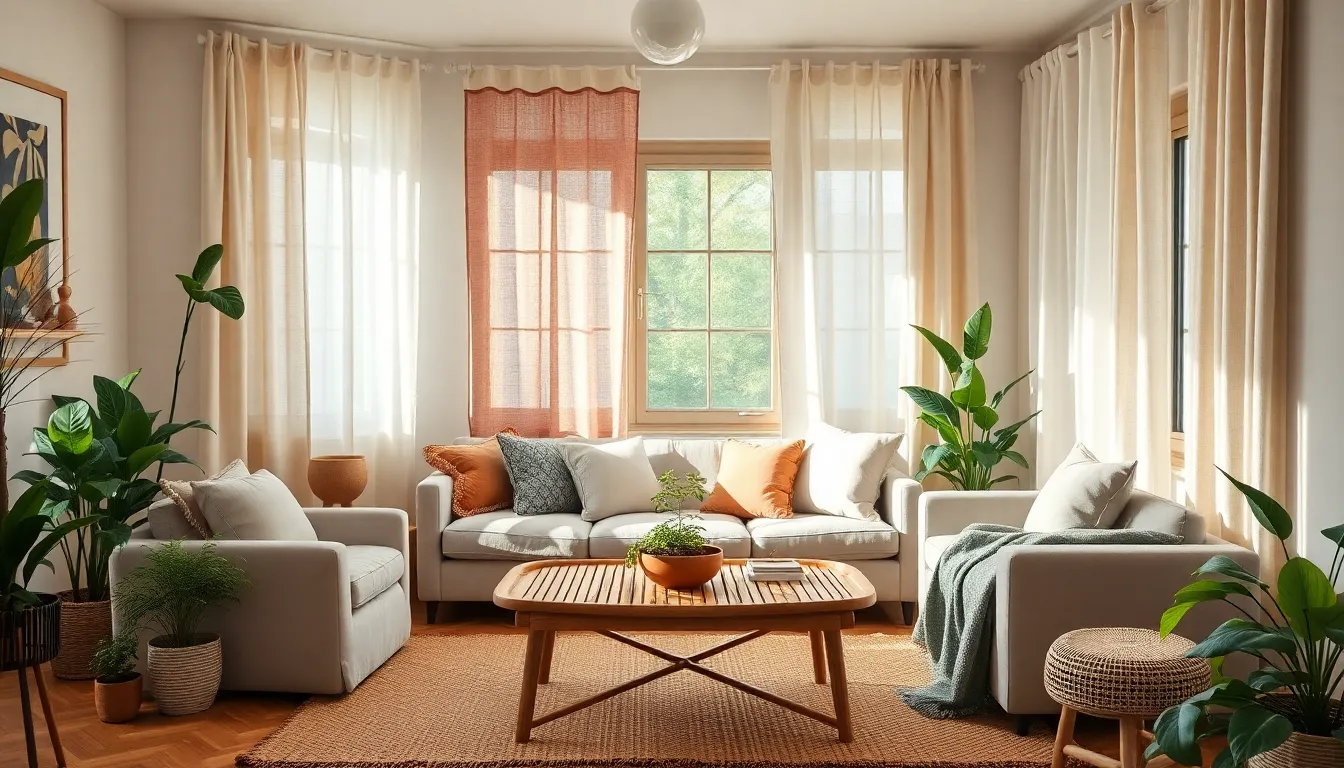
Choosing organic and non-toxic textiles transforms our living rooms into healthier spaces while supporting sustainable practices. These materials eliminate harmful chemicals from our homes and contribute to better indoor air quality.
Organic Cotton Throw Pillows and Curtains
Organic cotton throw pillows and curtains provide the perfect foundation for eco-friendly living room design. We can create stunning focal points using organic cotton pillows in various textures and patterns while avoiding harsh chemicals and synthetic dyes that pollute both our air and the environment.
Curtains made from organic cotton offer excellent light control and privacy while promoting healthier indoor air quality. We’ll find that these window treatments come in many colors achieved through natural dyeing processes that eliminate toxic substances from our living spaces.
Selecting organic cotton textiles supports eco-friendly farming practices that use minimal water and avoid harmful pesticides. Fabrics dyed using natural dyes create an even more sustainable option that reduces environmental impact while adding beautiful color to our rooms.
Natural Fiber Rugs and Carpets
Jute rugs and carpets bring warmth and texture to our living rooms while remaining completely biodegradable. These natural fiber options add visual interest without contributing to environmental pollution and can be composted at the end of their lifecycle.
Sisal rugs offer exceptional durability and natural beauty that complements various design styles. We can choose from different weave patterns and natural colors that enhance our sustainable living room aesthetic while providing comfortable underfoot experiences.
Bamboo rugs create soft, luxurious surfaces that grow from one of the industry’s most renewable resources. Recycled fiber carpets made from repurposed materials reduce waste while offering comfortable flooring answers that support our commitment to sustainability.
Hemp and Linen Upholstery Options
Hemp upholstery delivers exceptional durability while requiring minimal water and pesticides during cultivation. This eco-friendly material resists pests and mold naturally, making it an ideal choice for sofas, chairs, and ottomans that need to withstand daily use.
Linen upholstery options made from flax plants provide breathable, natural comfort free from harsh chemical treatments. We can select from various linen weights and textures that suit different furniture pieces while maintaining our commitment to sustainable living.
Both hemp and linen materials improve with age, developing unique character and softness over time. These sustainable upholstery choices eliminate volatile organic compounds from our living spaces while creating comfortable seating that lasts for years.
Install Eco-Friendly Flooring Alternatives
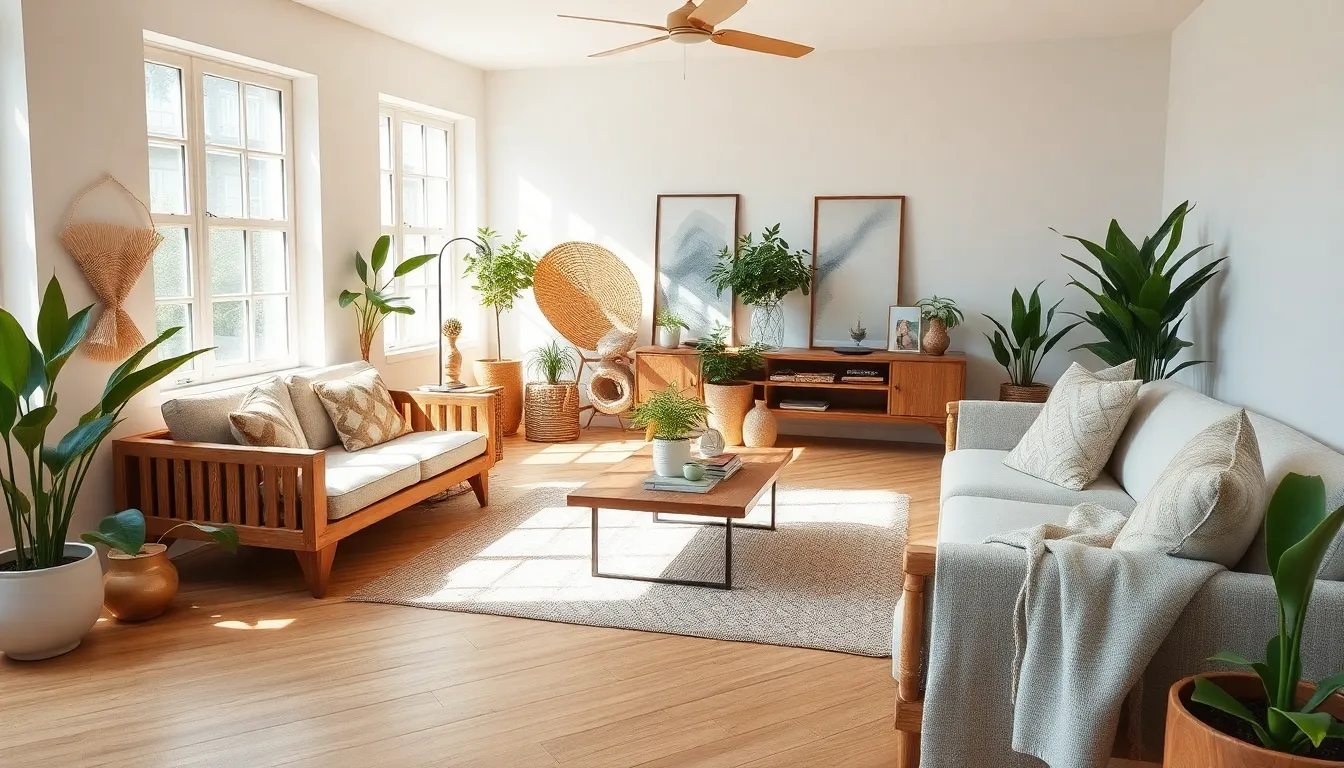
Continuing our journey toward sustainable living room design, we’ll explore flooring alternatives that significantly reduce environmental impact while maintaining style and durability. These options complement our organic textiles and natural materials beautifully.
Bamboo and Cork Flooring
Bamboo flooring offers remarkable sustainability since this rapidly renewable resource matures in just 5–7 years compared to decades for traditional hardwood. We appreciate bamboo’s modern, clean aesthetic that comes in various finishes and colors to match any green living room design. Durability makes bamboo an excellent long-term investment, though we should note it can be prone to scratching in high-traffic areas.
Cork flooring provides unique environmental benefits since it’s harvested from cork oak tree bark without cutting down the trees, allowing for repeated harvests. Natural insulation and sound-absorbing properties make cork particularly appealing for living spaces where comfort matters most. Resistance to mold and mildew adds another layer of health benefits, while the comfortable underfoot feel creates a warm, natural aesthetic that pairs beautifully with our sustainable furniture choices.
Reclaimed Hardwood Options
Reclaimed hardwood reduces demand for new lumber by utilizing wood salvaged from old buildings, barns, or factories, directly lowering deforestation rates. Sturdy construction and unique character marks create rich patinas that add rustic or industrial touches to our green living rooms. Each piece tells a story while contributing to our sustainable design goals.
Certified hardwoods from organizations like the Forest Stewardship Council (FSC) ensure responsible sourcing when reclaimed options aren’t available. We recommend seeking these certifications to maintain our commitment to environmental responsibility while achieving the hardwood look we desire.
Natural Stone and Tile Answers
Natural stone flooring options like slate or travertine offer exceptional longevity while requiring minimal energy for extraction compared to synthetic materials. Timeless appeal and high durability make stone an investment that complements our eco-friendly approach, though we should consider that it can feel cold underfoot and adds important weight to floors.
Recycled tile made from recycled glass or ceramic reduces waste and energy consumption while providing diverse style options. Various designs and textures add color and visual interest to our living rooms while supporting our sustainable lifestyle goals. These alternatives help reduce environmental impact and contribute to healthier indoor air quality by limiting materials that emit volatile organic compounds (VOCs).
Use Low-VOC and Natural Paint Colors
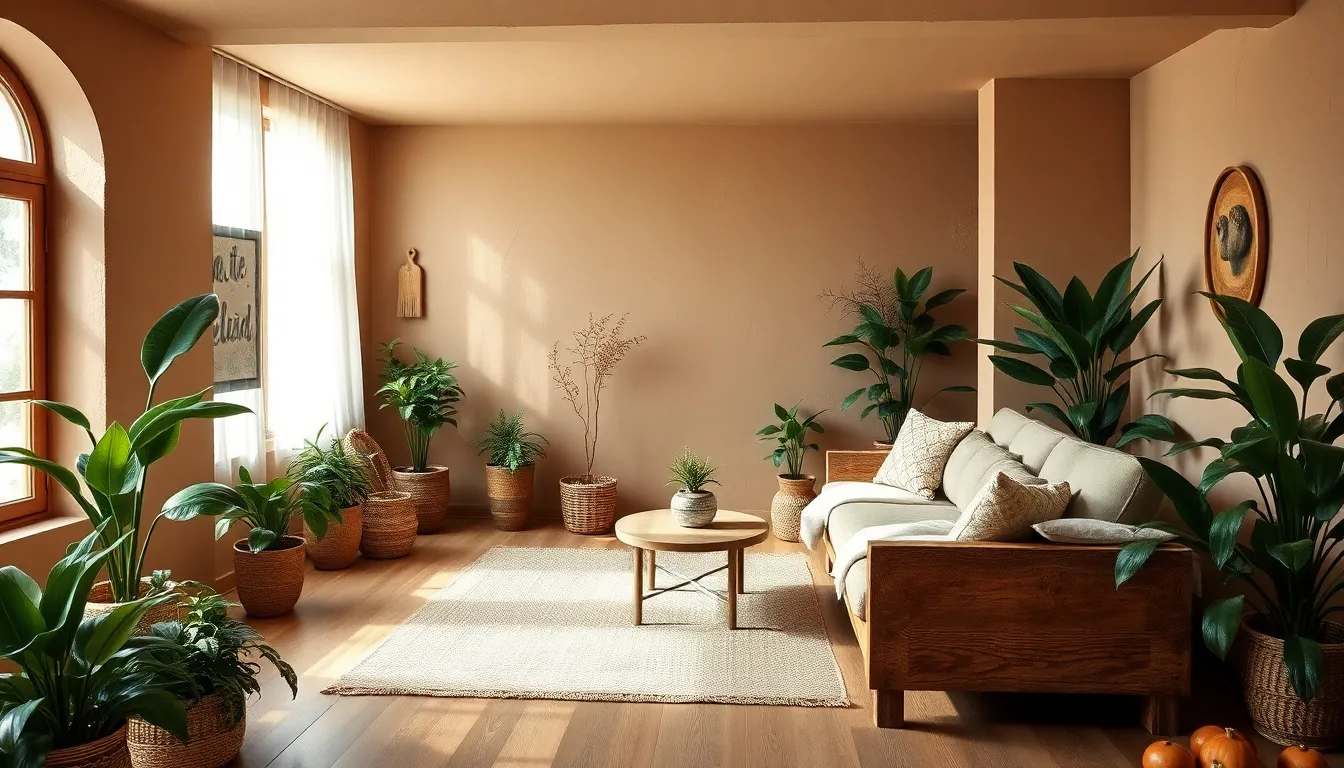
Selecting the right paint for our living rooms extends beyond color preferences to include health and environmental considerations. Low VOC paints release fewer harmful chemicals into the air, creating safer indoor environments while maintaining the aesthetic appeal we desire.
Earth-Tone Paint Palettes
Earth tone palettes featuring sage, olive, moss, and deep forest green create calming atmospheres that connect us with nature. These organic shades seamlessly integrate with natural materials like wood and stone, improving the sustainable elements we’ve already incorporated into our spaces. Sage green works beautifully with reclaimed wood furniture, while deep forest tones complement bamboo seating and natural fiber rugs. Olive and moss shades provide versatility that suits both modern minimalist designs and traditional cozy settings.
Non-Toxic Paint Brands and Options
Several reputable brands offer extensive selections of low VOC paints specifically designed for healthier homes. ECOS Paints provides completely non-toxic formulations in many green shades, making them ideal for households with allergies or chemical sensitivities. Benjamin Moore Natura delivers zero VOC options without compromising coverage or durability, while Sherwin-Williams Harmony actively reduces indoor air pollutants through advanced paint technology. These products are readily available at major home improvement stores and online retailers, ensuring easy access to safer paint alternatives.
| Brand | VOC Level | Special Features | Availability |
|---|---|---|---|
| ECOS Paints | Zero VOC | Completely non-toxic | Online and select stores |
| Benjamin Moore Natura | Zero VOC | Superior coverage | Nationwide retailers |
| Sherwin-Williams Harmony | Low VOC | Air purifying technology | Major home centers |
Natural Lime and Clay-Based Paints
Natural lime and clay based paints represent the pinnacle of eco friendly wall treatments, utilizing natural binders and pigments for breathable finishes. These innovative products regulate humidity naturally while resisting mold growth, creating healthier indoor environments that complement our sustainable living goals. American Clay offers stunning earth tone options with unique matte textures that add visual interest to living spaces. Earth Pigments provides traditional lime based paints that have been used for centuries, ensuring both sustainability and longevity. These biodegradable options eliminate concerns about toxic disposal while delivering distinctive finishes that conventional paints cannot replicate.
Implement Water-Saving and Energy-Efficient Features
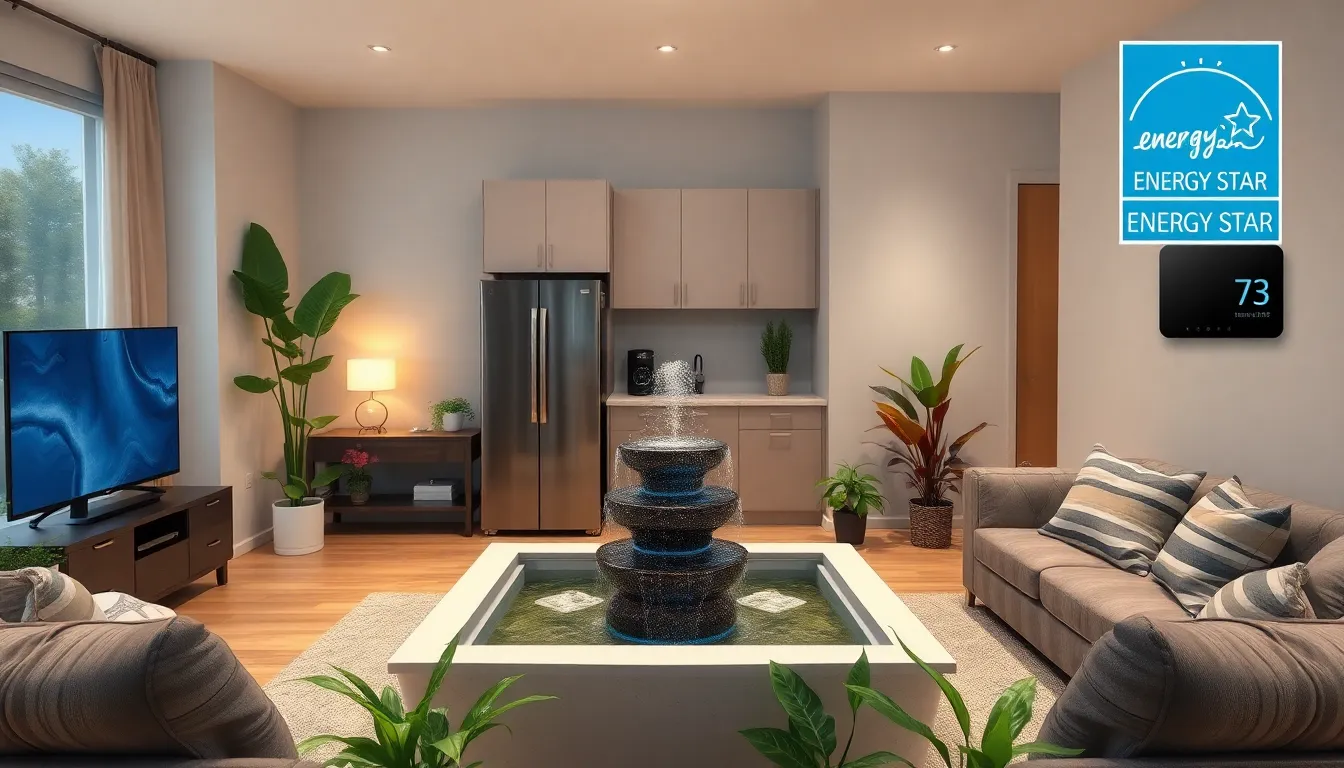
Building on our sustainable living room foundation, we can further reduce our environmental impact by integrating advanced water and energy management systems. These smart technologies help us optimize resource consumption while maintaining comfort and functionality.
Smart Thermostats and Climate Control
Installing smart thermostats enables precise climate control, helping to regulate heating and cooling efficiently throughout our living spaces. These devices optimize energy use by learning user habits and adjusting temperatures automatically, contributing to lower utility costs and reduced environmental impact. Programmable features allow us to create customized schedules that align with our daily routines, ensuring we’re not wasting energy when the room isn’t occupied.
Advanced models connect to our smartphones and home automation systems, giving us remote control capabilities and real-time energy usage monitoring. Temperature sensors in these systems detect occupancy patterns and natural light changes, automatically adjusting settings to maintain comfort while minimizing energy consumption. Learning algorithms continuously improve efficiency by analyzing our preferences and environmental conditions over time.
Water-Efficient Indoor Fountains
Indoor fountains can be designed with recirculating pumps and covered reservoirs to minimize water loss through evaporation in our living rooms. Choosing models with adjustable flow settings further reduces water consumption while improving the room’s ambiance with soothing water sounds. Closed-loop systems eliminate the need for constant water refilling, making these features both environmentally responsible and low maintenance.
Water-efficient fountain designs incorporate overflow protection and automatic shut-off mechanisms to prevent waste. Natural stone and ceramic materials for fountain construction complement our sustainable design choices while providing durability and easy cleaning. Positioning these fountains near plants creates microclimates that benefit both the water feature and our indoor greenery.
Energy Star Rated Electronics and Appliances
Selecting Energy Star rated electronics and appliances for the living room ensures devices operate efficiently and consume less electricity. Items such as televisions, lamps, and smart home devices with this certification help lower energy bills and decrease overall household emissions. These certified products use advanced technology to deliver the same performance while consuming significantly less power than standard alternatives.
| Feature | Benefit |
|---|---|
| Energy Star TVs | 25% less energy consumption than conventional models |
| Smart lighting systems | Up to 80% energy savings compared to traditional bulbs |
| Certified sound systems | Automatic standby modes reduce phantom energy draw |
| Energy efficient fans | Variable speed controls optimize airflow and power usage |
Modern Energy Star appliances include features like automatic power management, sleep modes, and variable speed controls that adapt to our usage patterns. Entertainment centers with certified components create comprehensive energy savings while providing the technology we need for modern living. Choosing these efficient options helps us maintain our commitment to sustainable living without sacrificing the conveniences that make our green living rooms both functional and enjoyable.
Create DIY Eco-Friendly Decor and Storage Solutions
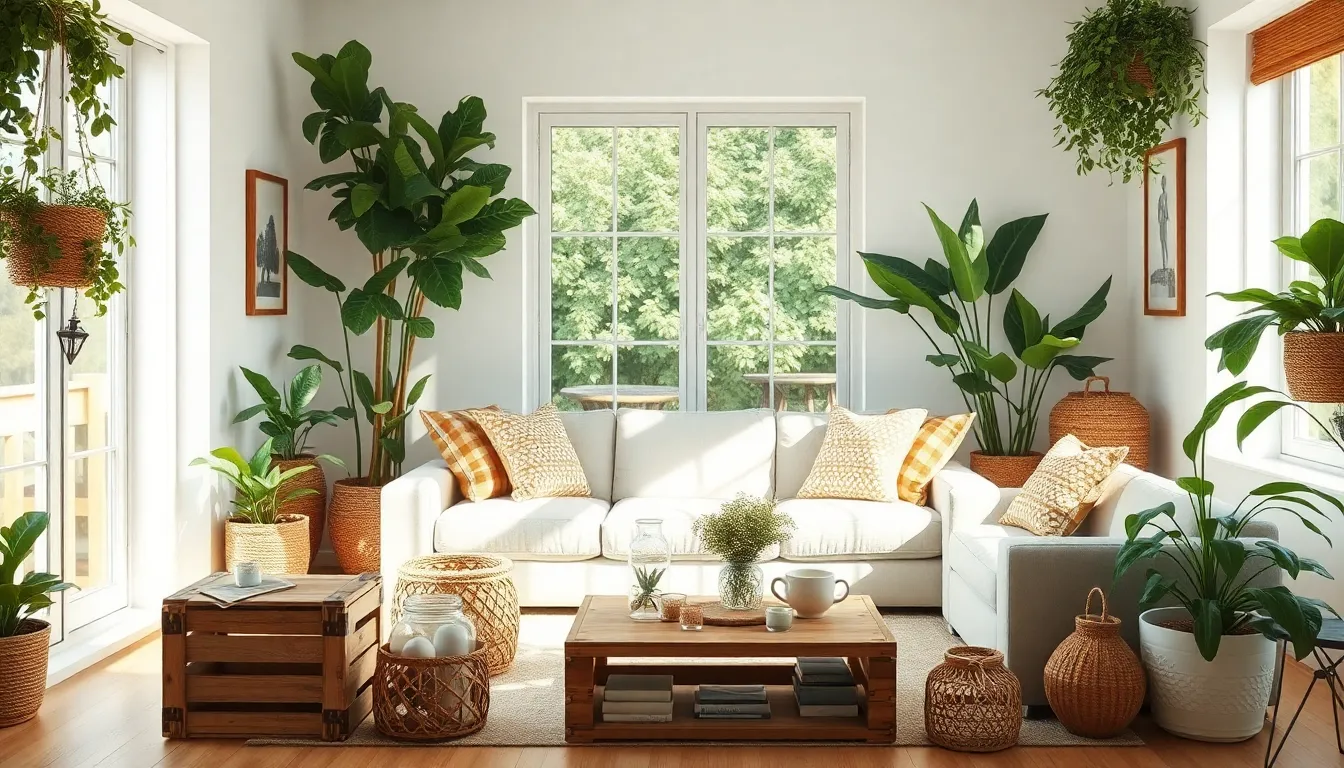
Building upon our sustainable foundation, we can transform everyday waste into functional art pieces that serve dual purposes in our green living spaces. These DIY projects not only reduce landfill contributions but also add personalized character that reflects our environmental values.
Upcycled Storage Containers and Organizers
Transform discarded materials into stylish storage answers that organize our living spaces while honoring sustainability principles. Old glass jars become magazine holders when we paint them with non-toxic, eco-friendly paints that won’t introduce harmful chemicals into our homes. Wooden crates from local markets serve as perfect remote control organizers or create supply containers.
Customize these containers using natural decorating techniques like twine wrapping, fabric decoupage with organic cotton scraps, or wooden embellishments from fallen branches. Tin cans work exceptionally well for pencil holders or small plant containers when we sand their edges smooth and apply earth-tone colors. These personalized touches ensure each piece becomes a unique conversation starter while reducing waste streams.
Maximize functionality by grouping containers of varying sizes to create comprehensive organization systems. Large storage boxes can house seasonal throws, while smaller containers manage charging cables and tech accessories in an orderly fashion.
Handmade Natural Fiber Baskets
Weave sustainable storage using natural materials like jute, seagrass, rattan, or bamboo that provide biodegradable alternatives to plastic organizers. These materials bring organic textures that complement our green living room aesthetic while supporting ethical artisan production. Handmade baskets ensure we’re avoiding mass-produced plastic alternatives that contribute to environmental pollution.
Create versatile storage answers that handle everything from throw pillows and blankets to children’s toys and books. Seagrass baskets offer exceptional durability and naturally resist moisture, making them perfect for areas near windows or plant displays. Bamboo weaving provides lightweight yet sturdy containers that stack efficiently for compact storage.
Support local artisans by purchasing handmade options or learning basic weaving techniques ourselves using sustainably sourced materials. This approach connects us with traditional crafting methods while ensuring our storage answers align with eco-conscious values.
Repurposed Glass and Metal Accessories
Reimagine discarded materials as decorative elements that extend product lifecycles while reducing landfill waste. Vintage glass jars transform into stunning terrariums or succulent planters that bring life to our coffee tables and shelving units. Mason jars serve multiple purposes as candle holders, vases for fresh flowers, or decorative bowls for natural potpourri.
Create metal accents from salvaged materials like old tin cans, wire scraps, or discarded hardware that become minimalist wall art or functional hooks. These repurposed pieces add industrial charm while demonstrating our commitment to waste reduction. Metal containers work beautifully for air plant displays or as unique pen holders on side tables.
Combine materials creatively by pairing glass elements with reclaimed wood or metal components to create layered decorative pieces. This mixing approach produces one-of-a-kind accessories that tell environmental stories while serving practical functions in our sustainable living spaces.
Maximize Natural Ventilation and Air Quality

Building on our sustainable design foundation, we need to focus on creating healthier indoor environments through improved airflow and air quality management. These elements work hand in hand with our eco-friendly materials and energy-efficient systems to complete the green living room transformation.
Strategic Window Placement and Ventilation
Cross-ventilation becomes essential when we position windows across from each other to naturally circulate air throughout our living spaces. This strategic placement reduces moisture buildup and removes indoor pollutants, supporting the healthier environment we’re creating with our green decor choices.
Operable skylights enhance both airflow and natural light availability, reducing our reliance on artificial lighting systems. Large glass doors or windows maintain that crucial visual connection to the outdoors while reinforcing our “bring the outdoors in” aesthetic that defines green living room design.
Window positioning directly impacts our energy consumption patterns since proper ventilation reduces the need for mechanical cooling systems. We can lower our carbon footprint significantly by designing spaces that work with natural air currents rather than against them.
Natural Air Purifying Systems
Indoor plants serve as proven air purification systems that efficiently remove toxins like formaldehyde and benzene from our living spaces. Snake plants, spider plants, and peace lilies work particularly well for cleaning indoor air while adding that essential natural element to our decor.
Grouping plants of various heights and types maximizes both air purification benefits and visual interest in our rooms. Tall trees like fiddle leaf figs paired with trailing vines like pothos create ever-changing displays that serve functional and aesthetic purposes simultaneously.
Vertical plant stands and hanging planters help us save precious floor space in smaller living rooms while maintaining our air quality goals. These answers allow us to incorporate more plants without cluttering our carefully designed sustainable spaces.
| Plant Type | Primary Benefits | Toxins Removed |
|---|---|---|
| Snake Plants | Low maintenance, nighttime oxygen production | Formaldehyde, benzene |
| Spider Plants | Easy propagation, humidity control | Formaldehyde, xylene |
| Peace Lilies | Flowering beauty, high air purification rate | Ammonia, benzene, formaldehyde |
| Fiddle Leaf Figs | Statement piece, large leaf surface area | General air pollutants |
| Pothos | Fast growing, versatile placement options | Formaldehyde, benzene, xylene |
Chemical-Free Cleaning Product Storage
Natural, non-toxic cleaning products support our indoor air quality goals while aligning perfectly with green living principles. We should store these eco-friendly alternatives in dedicated cabinets or storage areas to maintain organization and prevent exposure to any remaining conventional cleaners.
Storage answers need to keep all cleaning products safely out of reach of children and pets for optimal safety. This practice ensures our commitment to healthier living extends to every aspect of our home maintenance routine.
Chemical-free cleaning products eliminate volatile organic compounds that can compromise the air quality we’ve worked so hard to improve through ventilation and plant systems. These products work synergistically with our other green living room strategies to create truly sustainable indoor environments.
Conclusion
Creating a sustainable living room doesn’t mean compromising on style or comfort. We’ve shown you how thoughtful choices in furniture materials lighting textiles and decor can transform your space into an eco-friendly haven that reflects your environmental values.
The beauty of green living room design lies in its flexibility and long-term benefits. From energy-efficient lighting systems to air-purifying plants every element works together to reduce your carbon footprint while creating a healthier more beautiful home environment.
We encourage you to start small with one or two sustainable changes and gradually build your green living room over time. Your wallet your health and the planet will thank you for making these conscious design decisions that prove sustainability and style go hand in hand.
Frequently Asked Questions
What are green living room ideas?
Green living room ideas focus on creating sustainable, eco-friendly spaces that minimize environmental impact while maintaining style and comfort. These concepts include using eco-friendly materials, repurposed furniture, energy-efficient lighting, and incorporating plants for air purification. The goal is to design beautiful living spaces that reduce carbon footprints through conscious material choices and sustainable practices.
How can I incorporate plants into my living room design?
Large floor plants like fiddle leaf figs and monstera deliciosas work as stunning statement pieces while purifying air. For smaller spaces, use hanging gardens, wall-mounted planters, and low-maintenance succulents like aloe vera and jade plants. These natural elements enhance ambiance, improve air quality, and maximize greenery even in compact living areas.
What are the best eco-friendly furniture materials?
Reclaimed wood furniture offers unique character while reducing environmental impact. Bamboo and rattan provide sustainable, durable seating options with aesthetic appeal. Vintage and secondhand furniture extends product lifecycles and reduces demand for new resources. These materials combine sustainability with style, creating functional pieces that last for years.
How can I make my living room lighting more energy-efficient?
LED bulbs consume 75% less energy than traditional bulbs and last significantly longer. Smart lighting systems automatically adjust brightness based on occupancy and natural light levels. Maximize natural light with sheer curtains and strategic mirror placement. Solar-powered accent lighting utilizes renewable energy for eco-friendly illumination options.
What are the benefits of organic textiles in living rooms?
Organic cotton throw pillows and curtains avoid harmful chemicals while providing beautiful focal points. Natural fiber rugs like jute and sisal are biodegradable, durable, and add texture without environmental pollution. Hemp and linen upholstery eliminate volatile organic compounds, improve with age, and create healthier indoor environments for families.
What eco-friendly flooring options are available?
Bamboo flooring is rapidly renewable and highly durable. Cork offers natural insulation and sound absorption with sustainable harvesting practices. Reclaimed hardwood reduces demand for new lumber, while certified hardwoods ensure responsible sourcing. Natural stone and recycled tiles provide longevity with minimal energy requirements and better air quality.
How do I choose eco-friendly paint colors?
Select low-VOC paints from brands like ECOS Paints, Benjamin Moore Natura, or Sherwin-Williams Harmony for healthier indoor air. Earth-tone palettes including sage, olive, and forest green create calming environments that complement natural materials. Natural lime and clay-based paints regulate humidity, resist mold, and provide unique sustainable finishes.
What energy management systems work best for sustainable living rooms?
Smart thermostats optimize energy use by learning habits and providing precise climate control, reducing utility costs. Energy Star rated electronics and appliances ensure efficient consumption. Water-efficient indoor fountains with recirculating pumps minimize water waste while adding ambiance. These systems maintain comfort while supporting environmental responsibility.
How can I create DIY eco-friendly storage solutions?
Transform everyday waste into functional storage using old glass jars and wooden crates as organizers. Create handmade natural fiber baskets from jute, seagrass, and bamboo for sustainable storage options. Repurpose glass and metal accessories as decorative elements that extend product lifecycles while reducing landfill contributions and adding personalized character.
How can I improve natural ventilation and air quality?
Position windows strategically for cross-ventilation and install operable skylights for enhanced airflow. Use indoor plants like snake plants, spider plants, and peace lilies as natural air purifiers. Maintain chemical-free cleaning products and store them safely. These methods create healthier indoor environments while reducing reliance on artificial air conditioning systems.

